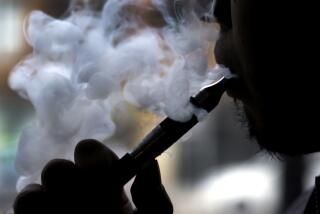Changing policies mean smoking is still a hot topic
- Share via
Smoking is a burning issue this fall in some major tourist spots.
New York’s mayor has vowed to snuff it out at the city’s bars and restaurants. Florida voters last week considered a wide-ranging ban. Even in hang-loose Hawaii, some islands are starting to limit where you light up.
It might seem as if there’s nowhere left to grab a cigarette.
Well, not quite, but the options are dwindling.
For travelers, whether they smoke or want to avoid those who do, the challenge is to keep up with ever-changing policies. Here is a snapshot of policies in various places and conveyances in the U.S. The most definitive authority, of course, is your hotel or city, or the cruise line, airport or train you’re using.
States and cities: California, in 1994, and Delaware, just this May, approved statewide smoking bans in workplaces, including bars and restaurants. As of the Travel section’s deadline Tuesday, it wasn’t known whether Florida would become the third “nonsmoking” state.
In the rest of the country, the laws vary by county or city. As of Oct. 16, more than 2,300 U.S. cities, counties and other local governments restricted tobacco in some way, according to the American Nonsmokers’ Rights Foundation, a national lobbying group based in Berkeley. More than 900 of them curbed smoking to some degree in restaurants (112 banned it), 111 in free-standing bars (82 banned it) and 1,101 in workplaces (172 banned it). For a list, visit www.no-smoke.org.
The New York City Council on Tuesday is expected to consider whether to extend an earlier smoking ban (at office buildings and restaurants seating more than 35) to all restaurants and bars, including outdoor cafes.
In Hawaii, restrictions at restaurants are in effect on Oahu, including Honolulu, and are to begin Jan. 1 on Maui, Lanai and Molokai. The Kauai County Council last month approved a similar policy to start Jan. 1; the bill was awaiting action by the mayor at the Travel section’s deadline. The Big Island is also considering restrictions.
Hotels: Hotels are generally setting aside fewer guest rooms for smokers and more for nonsmokers than they once did, experts say.
At Ritz-Carlton, 10% or fewer rooms chainwide, on average, allow smoking, spokeswoman Stephanie Platt says, a decided decrease from the past.
From 1998 to 2001, the percentage of nonsmoking guest rooms increased from 61% to 65% at U.S. hotels, according to a survey prepared for the American Hotel & Lodging Assn. You’re more likely to find nonsmoking rooms at an upscale hotel or a B&B; (both 72% of all rooms) than at a budget hotel (46%). By contrast, hotels that get lots of international visitors are more likely to accommodate smokers, says Dennis Koci, senior vice president of operations support for Hilton.
Hilton maintains about three-fourths of its rooms as nonsmoking and also offers “swing rooms” that can be used either way, he says.
But “the problems we have putting a nonsmoker in a smoking room are just unbelievable,” he says. For some hoteliers, it’s not worth the hassle. Three years ago, Kimpton Group’s Hotel Vintage Court in San Francisco, which said about 95% of its guests asked for nonsmoking rooms, went smoke-free.
Public areas at hotels, such as restaurants and lobbies, typically vary according to local laws.
Airports and airplanes: Since 2000, all scheduled flights to and from the U.S. have been required by federal law to be smoke-free; the ban on domestic flights dates to 1990. Russia’s Aeroflot was a holdout, but in March it went smoke-free too.
Some airports allow smoking in walled-off rooms, some in bars and restaurants, some at airlines’ first-class lounges, some only on outdoor patios -- or a combination of these.
LAX spokeswoman Nancy Castles says there are enclosed, ventilated smoking rooms at the Tom Bradley, No. 2 and No. 7 terminals’ “in transit” lounges, where foreigners are confined between international flights. “They technically haven’t entered the country,” she explains. Otherwise smoking is allowed outside the terminals or on two outdoor patios at Terminals 3 and 6.
Unofficial lists of airport policies can be found at www.pmoptions.com, www.smokingsection.com and www.no-smoke.org.
Cruise ships: Most of the major lines active in the U.S. market allow smoking in cabins and in designated public areas.
A major exception is Carnival’s Paradise, introduced in 1998, which may be the world’s only large cruise ship that is smoke-free. It even bans possession of smoking materials. Violators can be booted off the ship at the next port of call and fined $250. A couple of people per month get caught, says spokeswoman Jennifer de la Cruz.
On other Carnival ships, passengers can smoke in cabins and in bars and open deck areas but not in dining rooms or show lounges, she adds.
Cunard’s QE2 has smoking areas in its lounges, bars and dining rooms, and even sets aside two public rooms for cigar smokers. “Many more Europeans than Americans enjoy smoking,” says spokeswoman Julie Davis.
But typical of a trend, Costa Cruises, which also has many European customers and once had one of the more liberal smoking policies, instituted a smoke-free policy for all its showrooms and dining rooms in December 2001. Passengers wanted the change, says spokesman Darren Oster.
Trains: Smoking is generally banned on “non-overnight” Amtrak trains, that is, shorter routes. Smoking is allowed on overnight (long-distance) trains, with some exceptions, such as the entire Coast Starlight, which runs between Los Angeles and Seattle, and the Pennsylvanian, which runs between Chicago and Philadelphia, and parts of some other routes. Where allowed, smoking is confined to a special lounge car.
This is my favorite Amtrak rule: You can’t smoke in station waiting rooms smaller than 1,100 square feet; you can in bigger waiting rooms, in designated areas, unless local laws forbid it.
Get out the tape measure -- and a law book.
*
Jane Engle welcomes comments and suggestions but cannot respond individually to letters and calls. Write Travel Insider, Los Angeles Times, 202 W. 1st St., Los Angeles, CA 90012, or e-mail jane.engle@latimes.com.
More to Read
Sign up for The Wild
We’ll help you find the best places to hike, bike and run, as well as the perfect silent spots for meditation and yoga.
You may occasionally receive promotional content from the Los Angeles Times.






